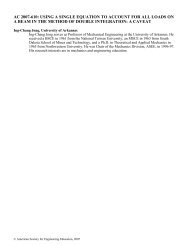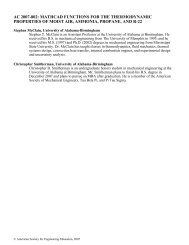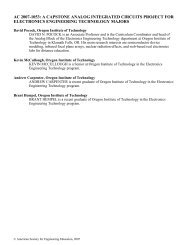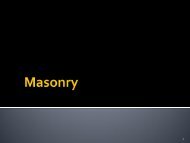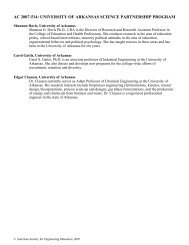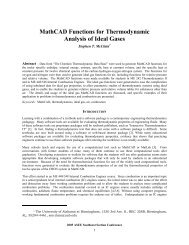Design of a Semantic Web-based Brokerage ... - Icee.usm.edu
Design of a Semantic Web-based Brokerage ... - Icee.usm.edu
Design of a Semantic Web-based Brokerage ... - Icee.usm.edu
You also want an ePaper? Increase the reach of your titles
YUMPU automatically turns print PDFs into web optimized ePapers that Google loves.
SearcherSearch for Course in BrokerAnonymous SearchGet Course DescriptionGet Course ServicesFIGURE 2CORE USE CASESCustomized SearchRefine Search• Identification <strong>of</strong> the aim and the scope <strong>of</strong> the ontology.• Consider to reuse existing vocabularies (in our case, wemake use <strong>of</strong> the elements defined on the data modelsidentified by the LT standardization process).• Enumerating the most important terms in the ontology.• Defining the classes and their hierarchy.• Defining the properties <strong>of</strong> the classes.• Defining the features <strong>of</strong> the properties.• Creating instances.In this way, the development <strong>of</strong> the ontology is aniterative process, centred on the architecture and driven by usecases, where each stage refines the previous one. As the usecases mature and are refined and specified in more detail,more <strong>of</strong> the ontology terms are discovered. This, in turn, canlead to new use cases. Therefore, both the ontology and theuse cases mature together.Users OntologyThis sub-ontology includes the properties and classes directlyrelated to the characterization <strong>of</strong> the users <strong>of</strong> the brokeragesystem. The terms identified in this namespace have beenmainly extracted from the data models Learning InformationPackage [16] and Accessibility [17], both developed by theIMS Consortium. The first <strong>of</strong> these standardized modelsidentifies the necessary elements to describe the characteristics<strong>of</strong> a (potential) student, whereas the second one extends theprevious model with elements that allow us to specify certainuser preferences. The existence <strong>of</strong> the user’s ontology inELEARNING-ONT makes it possible to the intermediationsystem the accomplishment <strong>of</strong> searches adapted to the userSession S3Hneeds and preferences in order to obtain more relevant resultsfor the client.Courses and Educational Resources OntologyMetadata is one <strong>of</strong> the most prolific fields in the LTstandardisation process. Almost all the institutions andorganizations involved in this process have made their ownproposals in this field. Currently, the Learning ObjectMetadata [18] model, developed jointly by several <strong>of</strong> theinstitutions involved in this process, is already an <strong>of</strong>ficialstandard <strong>of</strong> the IEEE. This standard, and in particular its RDFbinding, developed by Nilsson et al. [19], has been used as thebasis for the sub-ontology <strong>of</strong> ELEARNING-ONT that includesthe needed classes and properties to characterize academiccourses.This ontology is composed <strong>of</strong> 10 namespaces that groupclasses and properties related to a particular feature <strong>of</strong> thecourses: lom-base (which includes general classes used in theother namespaces), lom-general (with properties that allowspecifying the aggregation level and the type <strong>of</strong> structure <strong>of</strong>the <strong>edu</strong>cational resources), lom-lifecycle (with classes andproperties for the description <strong>of</strong> the resource life cycle), lommetametadata(that contains classes and properties to describethe metadata scheme used), lom-technical (which referencesthe technical requirements for the execution <strong>of</strong> the <strong>edu</strong>cationalresource), lom-<strong>edu</strong>cational (this is the most importantnamespace. It defines classes and properties which describepedagogical aspects <strong>of</strong> the resources), lom-rights (referringbasically to the costs and legal restrictions <strong>of</strong> the <strong>edu</strong>cationalresource), lom-relation (it contains a only property,isBasisFor), lom-annotation (that will be used add commentabout courses) and finally lom-classification (whose maintarget is to show the classification system in which theresource can be categorized).Educational Services Providers OntologyThis sub-ontology gathers some terms that allow makingdescriptions about <strong>edu</strong>cational services providers. These areentities or organizations that deliver courses on-linethroughout a particular e-learning platform. Due to the lack <strong>of</strong>standardized conceptual models in the e-learning domainrelated to this topic, we have taken from the e-commercedomain common use schemes that allow describingenterprises. Particularly, our sub-ontology is <strong>based</strong> on theEnterprise Ontology [20], developed by the ArtificialIntelligence Applications Institute from the University <strong>of</strong>Edinburgh.Educational Platforms OntologyOn-line courses are <strong>of</strong>fered to students throughout e-learningplatforms. We assume that an e-learning platform is a <strong>Web</strong>application that includes Internet tools and services within anenclosed space specifically configured and organized toprovide learning in a convenient and satisfactory way.0-7803-9077-6/05/$20.00 © 2005 IEEE October 19 – 22, 2005, Indianapolis, IN35 th ASEE/IEEE Frontiers in Education ConferenceS3H-21



